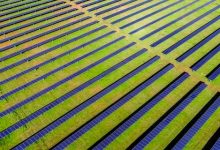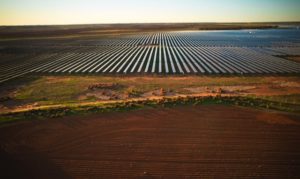The global Covid-19 pandemic is expected to hit planned wind and solar projects in Australia and other countries particularly hard, and wipe out any anticipated growth in renewables deployment in 2020, according to a new study.
The Norway-based Rystad Energy says it had expected global solar additions to grow 15% to 140 gigawatts in 2020, and wind additions to grow 6% to around 75GW. But it now expects this growth to be eliminated, and its forecasts for 2021 have also been cut by around 10 per cent.
Analysts and renewable energy developers have previously expressed concern about some sort of slowdown – due to a combination of supply bottlenecks and restrictions on the movement of people.
Rystad suggests a bigger impact could be felt in countries where the currency has declined sharply against the US dollar, and this will have a particular impact on Australia, where capital costs could rise by more than one third, along with Brazil, Mexico and South Africa,
“The full extent of the impact of Covid-19 on the renewable energy market is just beginning to reveal itself,” it says in a new report authored by senior vice president Gero Farruggio.
“Initial reactions focused on possible mass production shutdowns and supply chain bottlenecks in China. The lion’s share of renewable asset components is sourced from China, and projects under construction or in the procurement phase appeared particularly exposed when Covid-19 first struck.
“Yet thus far, it seems that global shipments have more-or-less arrived as expected, as Chinese panel and turbine suppliers returned to work relatively quickly, and production stabilized; panel prices have ultimately remained steady in recent weeks.
“Companies typically procure key project components in US dollars despite reaping revenue in local currency. Given this, projected returns on developments under procurement are already plummeting as unfavorable exchange rates result in soaring equipment prices. Utility wind is most at risk, as the percentage of wind development capex procured in US dollars is 25% higher than that of a utility solar PV.”

Farruggio says Australia will be one of the worst hit because its currency has fallen dramatically in recent weeks to a 17-year low.
“Developers already appear to have cooled on orders that were otherwise imminent,” he says. Much of the 2 GW utility PV solar expected to begin production 2020 in Australia is already built and going through the commissioning phase, which in many cases has been become long and complex, and in some instances heavily delayed.
“Work will continue on these projects. However, the key determiner of success will be the process of grid connection,” he notes.
But the outlook is not good for projects seeking financial close, and that will mean that the country will likely miss its expected installation of around 1.8GW of utility scale PV in 2021.
Wind, because of its longer lead times, is still expected to deliver 4.5 GW of finished wind turbine capacity between 2020 and 2021, but the 1.5GW worth of approved projects scheduled for 2022 are at risk of delay.
“We feel it is now unlikely that Australia will see a standalone wind farm reaching financial close in 2020,” Farruggio says.
Likewise, Farruggio expects the global solar market to be hit in a similar way to Australia, with companies pausing on procuring solar PV projects which would have been commissioned in and after 2021. “Countries most impacted in this sector will be from emerging markets in Asia, the Middle East, India and Latin America, where the bulk of solar growth had previously been expected,“ he says.
China and the US will be the least impacted by exchange fluctuations, and the number of solar installations in these countries is expected to remain fairly stable, although China may struggle to increase its solar capacity by 40 GW as initially forecasted.
In Europe, over 20 GW of solar capacity was expected pre-crisis. However, all of the Euro’s gains on the US dollar from the beginning of the year have now been lost. Foreign exchange issues for projects in Europe are less of an immediate concern but could take the forefront if the Euro falls further. Strict travel restrictions implemented across the continent have now halted projects under construction.
In Latin America, Mexico and Brazil have the greatest capacity of utility solar PV projects under construction. However, both countries are experiencing steep currency declines versus the US dollar and procurement is expected to come to a complete halt on most – if not all – projects yet to be committed. Projects hoping to be commissioned in 2021 will be significantly slowed or even indefinitely delayed.
Procurement in India is not expected to be impacted as much as in other regions facing depreciation, the report said. Previously Rystad Energy estimated the country would see 5.8 GW of utility solar PV projects starting up in 2020, increasing by 9.9 GW in 2021.










